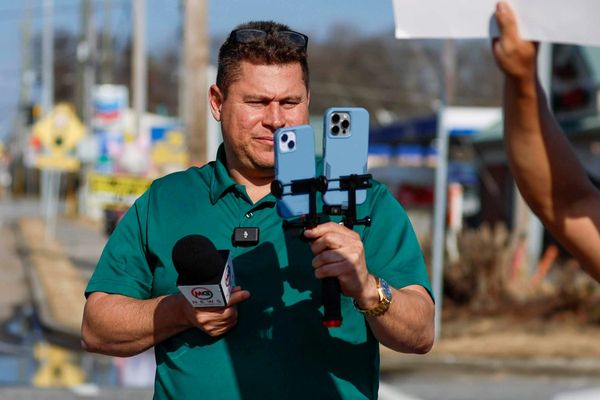
It was a critical and deliberate last-minute deployment on a previously unimportant part of the front. The Russians, having invaded in February 2022, had not anticipated that Ukraine would turn the tables and strike back with the first occupation of Russian territory since the second world war.
Had Moscow known that combat medics were quietly moving into the remote Sumy region, had the message gone up to the Kremlin, Russia might have been better prepared. The medics’ presence would only be required if an outbreak of heavy fighting was anticipated, in an area where none had taken place for over two years.
“We arrived on Monday last week. It had been equipped two days before that,” a surgeon told the Guardian between puffs on a cigarette. It would not be long before the first casualties arrived and days of intense work would begin: Ukraine’s audacious invasion of Russia began the following morning. Their work has been almost round the clock since. “We only get a few hours’ break a day,” another said.
Local civilian authorities, meanwhile, had no idea. Volodymyr Artyukh, the governor of Sumy region, said he found out “same time as you” and instituted an order to evacuate 7,000 people living between 5km and 10km from the border. As for the civilians, though many had seen a military buildup, giving the soldiers potatoes and other vegetables, the first they knew of the reason was when the villages were subjected to intense bombing in the daylight hours after the attack started.
Halyna Denina, 63, from Khrapivshchyna, one of a string of villages on the principal road from Sumy into Russia, said there was “really, really loud” shelling and her daughter’s grocery store was “bombed, completely bombed”. Speaking at refugee centre in Sumy, she said villagers had needed little persuading to evacuate, unlike in the eastern Donbas where there is a minority of stubborn pro-Russians willing to endure and remain.
Secrecy was paramount in an attack that had all the hallmarks of an operation planned by Ukraine’s relatively newly installed head of the armed forces, Col Gen Oleksandr Syrskyi, appointed in February by Volodymyr Zelenskiy after Gen Valerii Zaluzhnyi had to carry the can for last summer’s failed counteroffensive.
It was not just the obsession with surprise, as remarked on by soldiers involved in the attack, but also striking on a diversionary axis, opening a new front a long way from the main battle on the eastern front, where Russia is remorselessly advancing on the city of Pokrovsk. The last time Syrskyi tried something similar was in the autumn of 2022 when he commanded a successful lightning counterattack in Kharkiv province.
Using drones and satellite imagery for reconnaissance, Syrskyi’s style is to carefully map the territory and positions ahead. Ukraine had failed repeatedly in its efforts to breach Russia’s fortified lines between June and September 2023, but the commander will have realised that defences were minimal in Kursk oblast behind a border simply marked over exposed fields with double barbed-wire fences.
The plan was to rely heavily on tanks and faster-moving armoured vehicles, marked with painted or taped white triangles, to surge across the border up the roads, rushing through until they reached resistance. A Russian military blogger, Rybar, semi-independent of the Kremlin, summarising the approach said: “While one-third of them [the armoured vehicles] are restraining the stronghold, the others are bypassing it by entering nearby settlements and organising ambushes.”
Western armour was at the heart of the assault, with no apparent restrictions on their use, including US Stryker and German Marder armoured vehicles, with top speeds of about 60mph and 40mph respectively, and even reportedly some of Britain’s donated squadron of 13 remaining Challenger 2 tanks. But while there appeared to be evidence of the use of US Himars rocket artillery, there was no role for Anglo-French Storm Shadow missiles, deemed too long in range to be used inside Russia.
Russia’s defence ministry said the attack began at 8am on Tuesday 6 August with about 300 Ukrainian troops crossing the border, blue tape around their forearms to distinguish them from their enemies. A few dozen Russian border guards, including young conscripts, were swiftly ambushed. Drone videos that emerged a couple of days later showed a few dozen Russians lining up and surrendering in and around the checkpoint – the first of hundreds captured as prisoners of war.
Armoured vehicles raced up the road to the fringes of the western side of the town of Sudzha, about 6 miles from the frontline, on the first day, according to reports from Russian military bloggers. By the third day they had reached the outskirts of another village, Korenevo, about 13 miles inside the border, and they sought to radiate out further from roads running from Sudzha – before achieving their most successful attack in the incursion so far.
Between Thursday night and Friday morning last week, Ukrainian forces destroyed a Russian convoy on a highway 25 miles inside the border, in a strike whose accuracy and absence of artillery craters suggested it involved Himars rocket artillery. Dozens were probably killed in an ambush that contrasted Russian leaden-footedness – leaving a convoy exposed on the road – against Ukrainian agility.
Even allowing for the preparation, the success of the Kursk incursion is almost certainly greater than expected by Kyiv. A clue comes from the fact that Zelenskiy and other senior officials did not formally acknowledge what was going on until the weekend – while Russia had been providing updates from the very start – only to switch tack and start daily situation reports from the middle of this week as it became clear the attack was being sustained.
Syrskyi told Zelenskiy on Thursday in a video published by the Ukrainian leader that Kyiv’s forces had advanced by up to 35km (22 miles), gaining between 500 metres and 1.5km in the last 24 hours, compared with 1-2km reported the day before. The president then highlighted the growing bargaining power that the incursion was bringing. The number of prisoners of war available for exchange with Russia had been “further replenished”, he said, for the estimated 4,000 Ukrainians held in Russia.
A week and a half in and the incursion is largely popular with the Ukrainian public but not with all of the country’s troops, who worry about its risks and a rapidly deteriorating position on the eastern front, where a Russian thrust towards the road and rail hub of Pokrovsk is accelerating. Officials in Pokrovsk said the frontline was “just over 10km from the outskirts of the city”, a gain of 5km in a week.
Vladimir Putin, meanwhile, promised a “worthy response”, though the continuing surrenders and loss of territory demonstrate that the Kremlin has yet to formulate an effective counterattack. About 200,000 Russian civilians have had to be evacuated from their homes so far, and at some point more of Moscow’s forces may have to be pulled from the 500,000 or so Russian troops currently inside Ukraine to try to deliver a knockout blow.
Eventually, that could be to Ukraine’s advantage, said Lt Col Bohdan Krotevych, the chief of staff of Ukraine’s Azov brigade, who is based on the eastern front. “The Kursk operation, it’s very good and brave idea,” he said. “But other problems on the battlefield didn’t disappear. It depends on time that we can hold frontline in Kursk. If it will be a long time, I think Russians start to throw their reserve units from Pokrovsk to Kursk.”
Students of history, of whom Putin is one, know that the famous 1943 battle of Kursk began with the Nazis advancing for a week before the Soviets counterattacked and won decisively. A difference, however, was that at that time Moscow knew the German plans in advance (partly because information had been shared by British intelligence). Now, in 2024, both sides know that the battle in a month could look very different in nature from now.
A Ukrainian soldier involved in the Kursk operation, sharing his opinion on condition on anonymity, captured the uncertainty ahead. “I don’t know the general idea,” he said. “Our units who assault are doing an insanely tough job. The enemy is resisting with battles too. We need reserve troops, otherwise this success will be destroyed. Yes, Russians could push back.”







